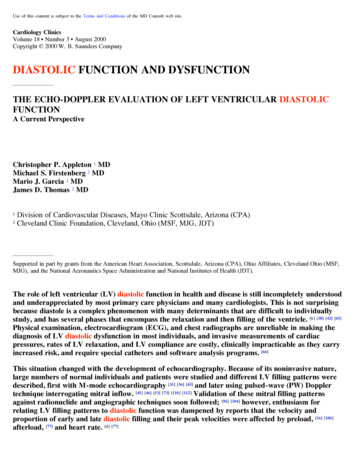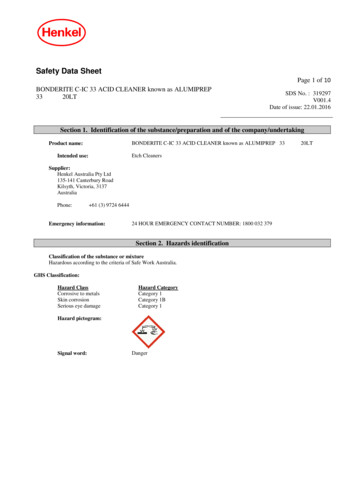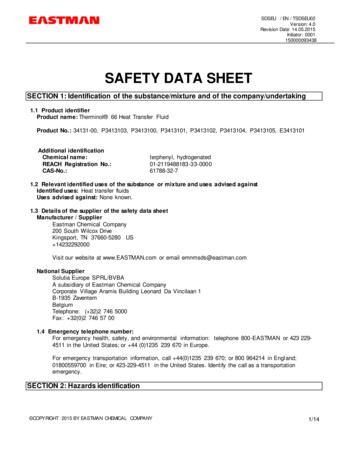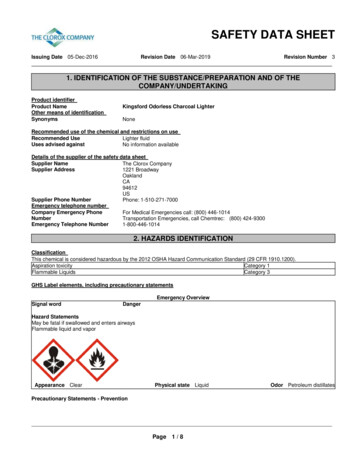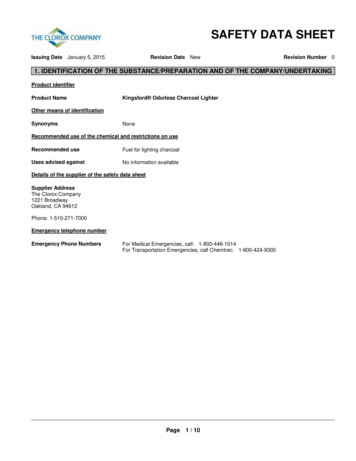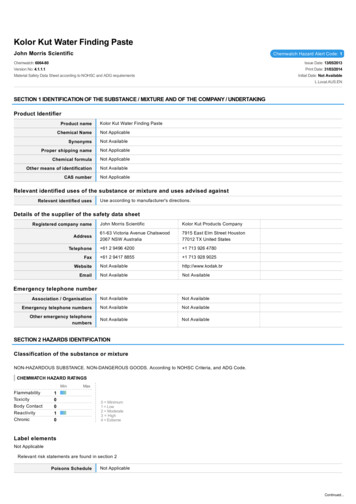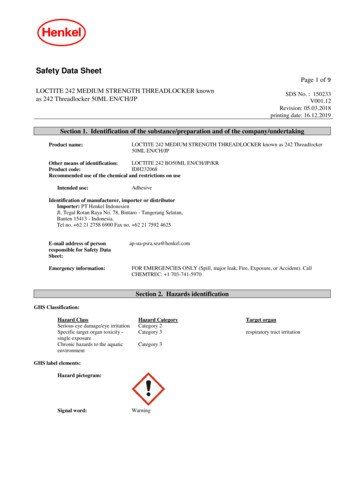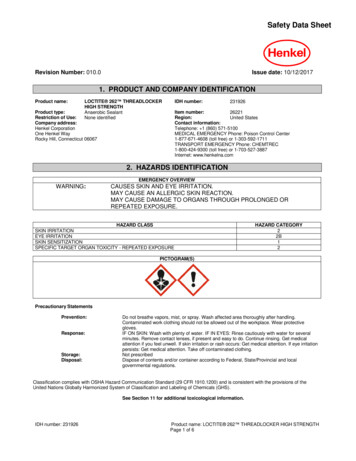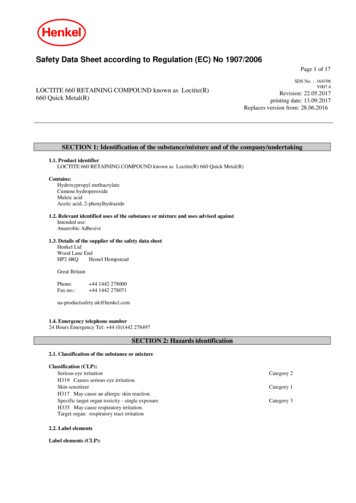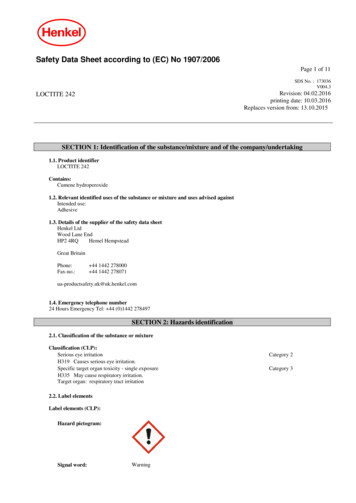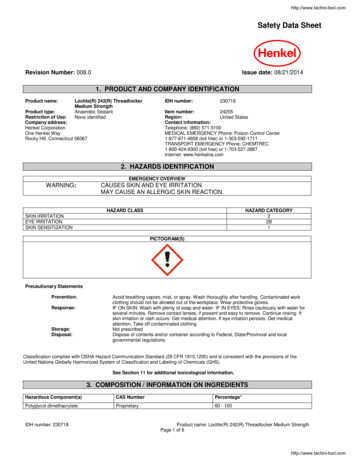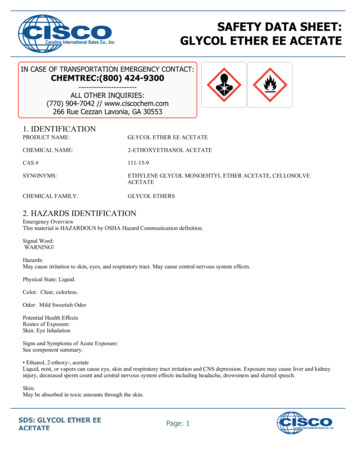
Transcription
SAFETY DATA SHEET:GLYCOL ETHER EE ACETATEIN CASE OF TRANSPORTATION EMERGENCY CONTACT:CHEMTREC:(800) 424-9300----------------------ALL OTHER INQUIRIES:(770) 904-7042 // www.ciscochem.com266 Rue Cezzan Lavonia, GA 305531. IDENTIFICATIONPRODUCT NAME:GLYCOL ETHER EE ACETATECHEMICAL NAME:2-ETHOXYETHANOL ACETATECAS #111-15-9SYNONYMS:ETHYLENE GLYCOL MONOEHTYL ETHER ACETATE, CELLOSOLVEACETATECHEMICAL FAMILY:GLYCOL ETHERS2. HAZARDS IDENTIFICATIONEmergency OverviewThis material is HAZARDOUS by OSHA Hazard Communication definition.Signal Word:WARNING!Hazards:May cause irritation to skin, eyes, and respiratory tract. May cause central nervous system effects.Physical State: Liquid.Color: Clear, colorless.Odor: Mild Sweetish OdorPotential Health EffectsRoutes of Exposure:Skin. Eye InhalationSigns and Symptoms of Acute Exposure:See component summary. Ethanol, 2-ethoxy-, acetateLiquid, mist, or vapors can cause eye, skin and respiratory tract irritation and CNS depression. Exposure may cause liver and kidneyinjury, decreased sperm count and central nervous system effects including headache, drowsiness and slurred speech.Skin:May be absorbed in toxic amounts through the skin.SDS: GLYCOL ETHER EEACETATEPage: 1
Inhalation:Vapor or mist is irritating to the respiratory tract.Eye:Vapor or mist is irritating to the respiratory tract.Ingestion:May cause headache, dizziness, nausea, vomiting, gastrointestinal distress, liver and kidney injury.Chronic Health Effects: See component summary. Ethanol, 2-ethoxy-, acetate Prolonged contact with skin and inhalation may lead to absorption of harmful amounts. Repeatedexposure at high concentrations may cause injury to bone marrow and blood cells, kidney, liver and testes. Reproductive toxin. Maycause developmental toxicity.Conditions Aggravated by Exposure: Any pre-existing disorders or diseases of the, central nervous system (CNS), liver, kidney,lungs, and/or, pregnancy3. COMPOSITIONCOMPONENT NAMEEthanol, 2-Ethoxy,acetateCAS #111-15-9OSHA PEL:100 PPMOSHA STEL:N/LACGIH TLV:5 PPM SKINCarcinogenic Listing:N/LConcentration by Wt/Mol%AVERAGEMIN: 99.0MAX 100.04. FIRST AID MEASURESTake proper precautions to ensure your own health and safety before attempting rescue and providing first aid. For specificinformation refer to the Emergency Overview in Section 3 of this MSDS.Inhalation: Move the exposed person to fresh air at once. If breathing has stopped, perform artificial respiration. When breathing isdifficult, properly trained personnel may assist the affected person byadministering oxygen. Keep the affected person warm and at rest. Get medical attention immediately.Eye: Flush with plenty of water for at least 15 minutes, occasionally lifting the upper and lower eyelids. Obtain medical attentionimmediately.Skin: Immediately remove excess chemical and contaminated clothing; thoroughly wash contaminated skin with mild soap andwater. If irritation persists after washing, seek medical attention. Thoroughlyclean contaminated clothing before reuse; discard contaminated leather goods (gloves, shoes, belts, wallets, etc.).Ingestion: If victim is conscious and able to swallow, have victim drink water to dilute. Never give anything by mouth if victim isunconscious or having convulsions. Induce vomiting only if advised by aphysician or Poison Control Center. CALL A PHYSICIAN OR POISON CONTROL CENTER IMMMEDIATELY!5. FIRE FIGHTING MEASURESNFPA: Health 1; Fire 2; Reactivity 0; Others:SDS: GLYCOL ETHER EEACETATEPage: 2
Flammability Classification:OSHA/NFPA Class II combustible liquid.Flash Point / Method:52 C (126 F)ASTM D-56 (Tag Closed Cup)Auto-Ignition Temperature:235 C (455 F)Flammable Limits:LOWER: 1.7 vol%UPPER: 14 vol%Hazardous Combustion Products:Carbon oxides (CO, CO2) Gives off irritating and/or toxic gases in a fire.Special Conditions to Avoid:Airborne mists from this substance are a moderate fire and explosion hazard.Extinguishing Media:SMALL FIRE: Use dry chemicals, CO2, water spray or alcohol-resistant foam. LARGE FIRE: Use water spray, water fog oralcohol-resistant foam.Fire Fighting Instructions:Protective Equipment/Clothing: Wear positive pressure self-contained breathing apparatus (SCBA). Structural firefighters protectiveclothing will only provide limited protection.INSTRUCTIONS: Fight fire from maximum distance or use unmanned hose holders or monitor nozzles. Cool containers withflooding quantities of water until well after fire is out. Move containers form fire area if you can do it without risk. Withdrawimmediately in case of rising sound from venting safety devices or discoloration of tank. Always stay away from tanks engulfed infire. For massive fire, use unmanned hose holders or monitor nozzles; if this is impossible, withdraw from area and let fire burn.6. ACCIDENTAL RELEASE MEASURESRelease Response:Eliminate all sources of ignition. All equipment used when handling this product must be grounded. Do not touch or walk throughspilled material. Stop leak if you can do it without risk. Prevent entry into waterways, sewers, basements or confined areas. A vaporsuppressing foam may be used to reduce vapors. Absorb or cover with dry earth, sand or other non-combustible material and transferto containers. Use clean non-sparking tools to collect absorbed material.Reportable Quantities:See Section 15: Regulatory Informaiton7. HANDLING AND STORAGEHandling:Containers, even those that have been emptied, will retain product residue and vapor and should be handled as if they were full. Donot eat, drink or smoke in areas where this material is used. After handling, always wash hands thoroughly with soap and water. Donot handle near heat, sparks, or flame. Avoid contact with incompatible agents. Use only with adequate ventilation/personalprotection. Avoid contact with eyes, skin and clothing. Do not enter storage area unless adequately ventilated. Metal containersinvolved in the transfer of this material should be grounded and bonded.Storage:Store containers in a cool, dry, ventilated, fire resistant area away from sources of ignition and incompatible materials. Keepcontainer tightly closed and properly labeled. Do not store in aluminum, zinc (galvanized) or other corrodible containers.8. EXPOSURE CONTROLS AND PERSONAL PROECTIONEngineering Controls:SDS: GLYCOL ETHER EEACETATEPage: 3
Use process enclosures, local exhaust ventilation, or other engineering controls to keep airborne levels below recommendedexposure limits. Emergency shower and eyewash facility should be in close proximity (ANSI Z358.1)Personal Protection:Inhalation:A respiratory protection program that meets OSHA's 29 CFR 1910.134 or ANSI Z88.2 requirements must be followed wheneverworkplace conditions warrant respirator use.Skin:Wear chemical resistant gloves such as rubber, neoprene or vinyl. Appropriate protective clothing should be worn to prevent skincontact.Eye:Wear safety glasses as minimum eye protection. Conditions may warrant the use of chemical goggles and possibly a face shield.Consult your standard operating procedure or safety professional for advice. Use protective eye and face devices that comply withANSI Z87.1-1987.9. PHYSICAL AND CHEMICAL PROPERTIESBoiling Point: 156 C (313 F)Vapor Pressure: 1.2 mm Hg @ 20 CSpecific Gravity: Solid/Liquid: 0.975 (Water 1)Vapor:4.72 (Air 1.0)Octanol/Water Partition Coefficient in Kow:pH: Not ApplicableViscosity: No data available.Water Solubility: Slightly soubleMelting/ Freezing Point: -62 C (-80 F)Evaporation Rate: 0.21 (butyl acetate 1)10. STABILITY AND REACTIVITYChemical Stability: Stable.Conditions to Avoid: Avoid contact with strong oxidizers, excessive heat, sparks or open flame. Use only in clean, dry, oxygen freestorage containers.Incompatibility with: Oxidizers, Acids, Alkalis Nitrates.Hazardous Products of Decomposition: Carbon Monoxide and Carbon dioxide.Hazardous Polymerization: Will not occur.Reactions with Air and Water: May form peroxides in the presence of air.11. TOXICOLOGICAL INFORMATIONComponent Summary: Ethanol, 2-ethoxy-, acetateLC50 (Inhl) Rat 12,100 MG/M3 8 HOURSLD50 (Oral) Rat 3900 MG/KGACUTE ORAL EFFECTS: Ethylene glycol monoethyl ether acetate is metabolized to ethylene glycol monoethyl ether (EGEE) inthe body. The toxicity of EGEE is believed to be due to the acid metabolite, ethoxyacetic acid. In an acute rat toxicity study, red cellSDS: GLYCOL ETHER EEACETATEPage: 4
hemolysis and kidney injury were recorded, while in a combined oral and inhalation study in the dog, hepatic injury occurred.SKIN EFFECTS: May be irritating to the skin.EYE EFFECTS: This product is expected to be a mild eye irritant.Repeated Dose Toxicity Testicular effects were found in mice receiving 1000 mg/kg/day, 5 day/week for 5 weeks. 2-ethoxyethylacetate is teratogenic and fetotoxic in the rat at dose levels of 130 ppm or more with no maternal toxicity, fetotoxicity andteratogenicity, 100 ppm was fetotoxic and 25 ppm was a no-effect level.CARCINOGENICITY: At the time of this review, no studies were found on the possible carcinogenic activity of this material inhumans or experimental animals.Reproductive / Development Effects Fertility effects, developmental abnormalities and fetotoxicity have been reported from animaltesting (rat). At the time of this review, no studies were found on the possible reproductive/developmental activity of this material inhumans.12. ECOLOGICAL INFORMATIONEcotoxicity:This material is highly soluble in water. Laboratory toxicity tests indicate that is not significantly toxic to fish and aquaticinvertebrates, although amphibians may be more sensitive. Wildlife species may be more susceptible since mammals and birds donot readily metabolize this material. The odor and flavor of this material may attract some wildlife and cause them to consumespilled material.Environmental Fate:This material should biodegrade after an acclimation period, and it is is not expected to be environmentally persistant. Due careshould be taken to avoid accidental releases to aquatic or terrestrial systems.Bioaccumulation:Because of this material's high solubility and rapid biodegradability, it is unlikely that bioaccumulation will occur in aquatic orterrestrial systems. Models estimate that this material will preferentially partition to water versus air or soil.13. DISPOSAL CONSIDERATIONSDispose of all waste and contaminated equipment in accordance with all applicable federal, state and local health and environmentalregulations. Recovery and reuse, rather than disposal, should be the ultimate goal of handling efforts. The materials resulting fromclean-up operations may be hazardous wastes and therefore, subject to specific regulations.14. TRANSPORT INFORMATIONProper ShippingName: Ethylene Glycol Monoethyl Ether AcetateDOT Hazard Class: 3UN/NA ID: UN1172Packing Group: PG IIILabels: Flammable Liquid.Marine Pollutant: NoNAER Guidebook: 129DOT Status: Regulated material.SDS: GLYCOL ETHER EEACETATEPage: 5
15. REGULATORY INFORMATIONTSCA:All components of this product are listed or are exempt from listing on the TSCA 8(b) inventory. If identified components of thisproduct are listed under the TSCA 12(b) Export Notification rule, they will be listed below.TSCA 12(b) ComponentSARA - Section 313 Emissions Reporting:Component Summary: Ethylene Glycol Monomethyl Ether AcetateReporting Threshold: 1.0%SARA - Section 311/312:Based upon available information, this material is classified as the following health and/or physical hazards according to Section 311& 312:Immediate (Acute) Health Hazard.Delayed (Chronic) Health Hazard.CERCLA Hazardous Substances and their Reportable Quantities:Fire Hazard.Component Summary:Reportable QuantityCalifornia Prop. 65:Proposition 65 requires manufacturers or distributors of consumer products into the State of California to provide a warningstatement if the product contains ingredients for which the State has found to cause cancer, birth defects or other reproductive harm.If this product contains an ingredient listed by the State of California to cause cancer or reproductive toxicity it will be listed below. Ethylene glycol monoethyl ether acetate, Reproductive and Developmental Toxin16. OTHER INFORMATIONDISCLAIMER OF RESPONSIBILITY:The information on this MSDS was obtained from sources which we believe are reliable. However, the information is providedwithout any warranty, expressed or implied, regarding its correctness. Some information presented and conclusions drawn herein arefrom sources other than direct test data on the substance itself. The conditions or methods of handling, storage, use and disposal ofthe product are beyond our control and may be beyond our knowledge. For this and other reasons, we do not assume responsibilityand expressly disclaim liability for loss, damage, or expense arising out of or in any way connected with handling, storage, use, ordisposal of this product. If the product is used as a component in another product, this MSDS information may not be applicable.Date Created: 6/30/2015Date Updated: 2/4/2016SDS: GLYCOL ETHER EEACETATEPage: 6
30.06.2015 · GLYCOL ETHER EE ACETATE 1. IDENTIFICATION PRODUCT NAME: GLYCOL ETHER EE ACETATE CHEMICAL NAME: 2-ETHOXYETHANOL ACETATE CAS # 111-15-9 SYNONYMS: ETHYLENE GLYCOL MONOEHTYL ETHER ACETATE, CELLOSOLVE ACETATE CHEMICAL FAMILY: GLYCOL ETHERS 2. HAZARDS IDENTIFICATION Emergency Overview This material is HAZARDOUS by OSHA Hazard Communication definition
